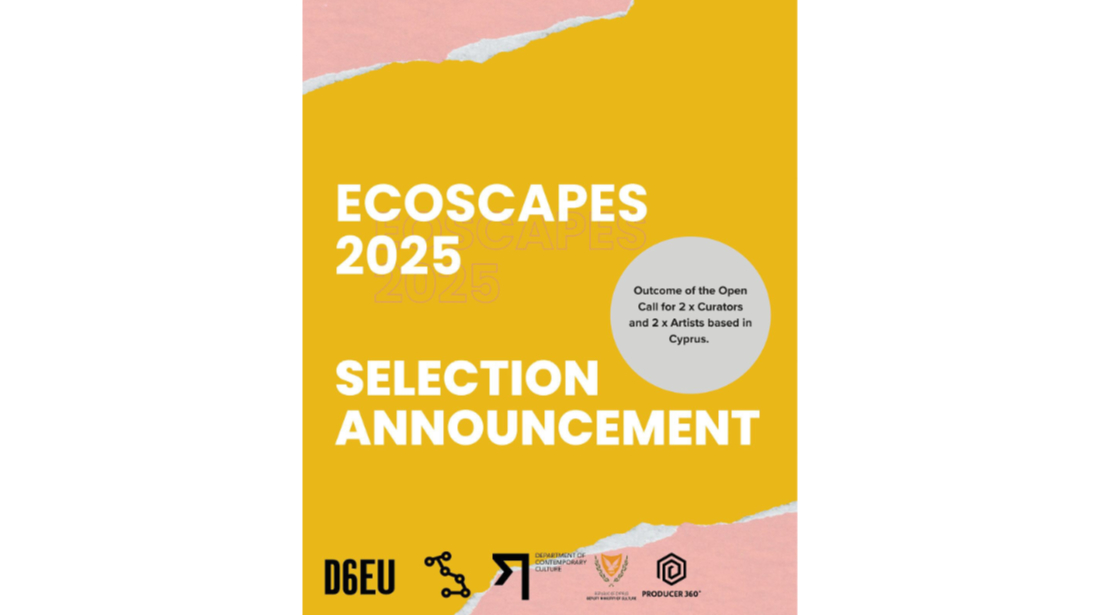
Marisa Satsia in conversation with Helene Black
Artists in dialogue
(Re)Grounding
Marisa Satsia in conversation with Helene Black.¹
8 April 2025
During her residency for (Re)Grounding (2024-2025)², bio artist Marisa Satsia generated new knowledge with local communities about the environmental state of local abandoned mines and presented new artwork and research in the exhibition ‘We Forgot How To Forage’ (6-10 December 2024).
Marisa’s work re-imagines the production of scientific knowledge and makes biology more accessible through the adoption of DIY processes, materials and tools.
In this conversation, Marisa and Cyprus-based artist, researcher and educator Helene Black delve into research concepts, methodology and creation, as well as their shared interest in the environmental impact of mining.
Helene Black: Marisa, before we commence on the environmental concerns of our discussion, can you outline your experience and interests that led you to Cypriot mines and the need for remediation?
Marisa Satsia: I met and collaborated with Ukrainian biohacker of Yane Lab, Dariia Dantseva³ in June 2024 during their visit to Cyprus for the (Re)Grounding residency programme to research and visit local copper mines. I must confess that prior to meeting Dariia, I did not know much about the history of the abandoned mines or their current environmental state. Dariia mentioned that Cyprus and Ukraine have a similar colonial extractivist past. From our conversation it was evident that most of the studies conducted on the abandoned mines were being carried out by scientists that are not members of the local community and that there is no awareness or local knowledge produced around the current environmental state and restoration of the abandoned mines.
All of the above made perfect sense since the lack of awareness of one’s surroundings, either cultural, economic, social or ecological, is one of the characteristics all colonial powers have in common. Through limiting and erasing the knowledge systems of the locals they aim to disarm and alienate us from our [environmental] surroundings and cultural identities. Colonisation is not only a political issue but also an ecological one. Colonisation did not only reduce the earth to a mere resource for the behest of capital and exploited our lands⁴, our commons, and our food, but it also colonised the way we think and communicate, the way we express ourselves, and our cultivation of knowledge and awareness [or lack of thereof].
We decided that the most effective way to alternatively engage with the colonial industrial history and extractivist legacy in Cyprus and to disseminate knowledge about the current state of the abandoned mines is through planning and implementing a DIY Biology workshop. As bio artists, our methodologies aim to produce scientific knowledge horizontally and to decolonise scientific knowledge production. Citizen science as a research and community engagement methodology can be achieved through expanding the research to engage artists, students, interested members of the public and bio-activists to generate awareness and new understandings about the current environmental state of abandoned mines on our island.
By using open-source tools and DIY biology resources based on citizen science research methodologies we are empowering the community to challenge and decolonise scientific knowledge production and challenge dominant power structures. These approaches allow for epistemic disobedience and non-conformity in artistic and scientific knowledge production and allow the decolonisation of knowledge. Citizen science is open and inclusive as it creates spaces for the development and dissemination of indigenous, ancestral and intergenerational knowledge, oral histories, community exchange, and lived experiences as novel forms of knowledge.
HB: Can you describe your preparation and on site methods you implemented in order to enable you to gather relevant data.
Together we developed a hands-on workshop where participants were encouraged to produce alternative forms of scientific knowledge outside the walls of scientific institutions. So, we conducted our scientific experiments on the contamination caused by copper mining to the bodies of water in Skouriotissa and Lefke. The participants learned how to test the collected water samples through swabbing on sterilised petri dishes that contained nutrient agar medium. The medium was prepared, sterilised and then poured into the petri dishes at home by Dariia. We also demonstrated how to label the petri dishes, seal them, and how to complete water sample tests using readily available (Figure 1).[1]
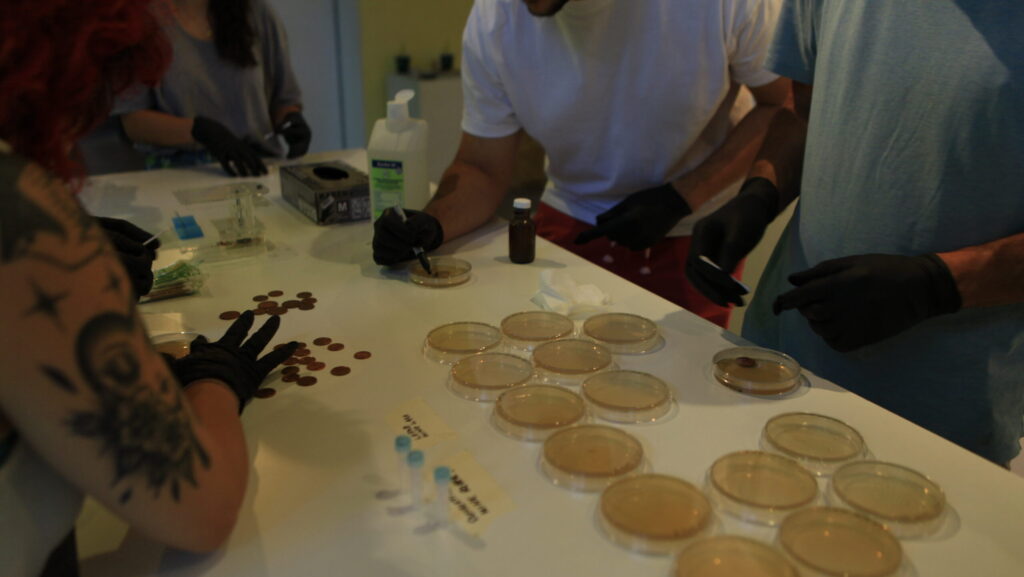
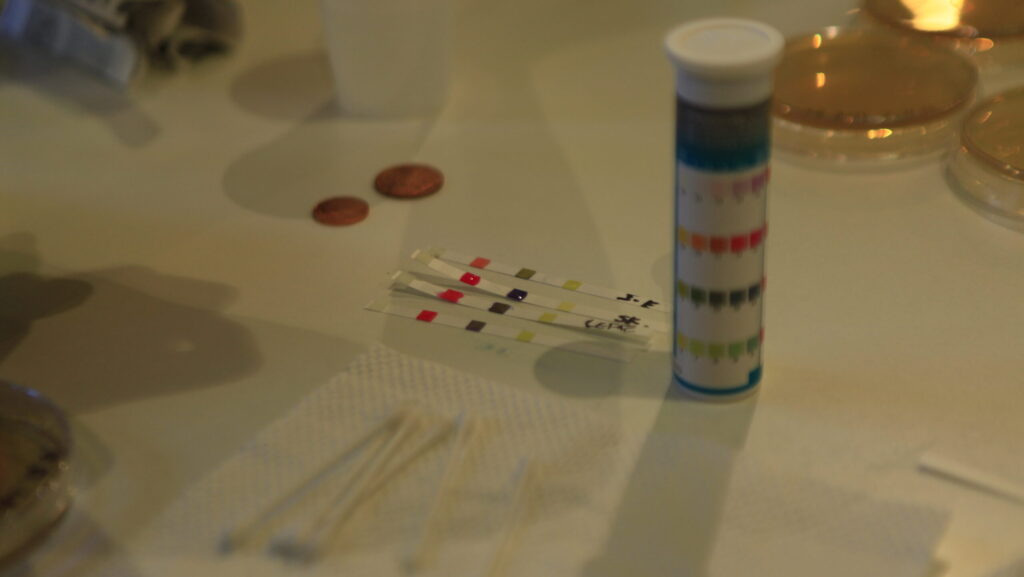
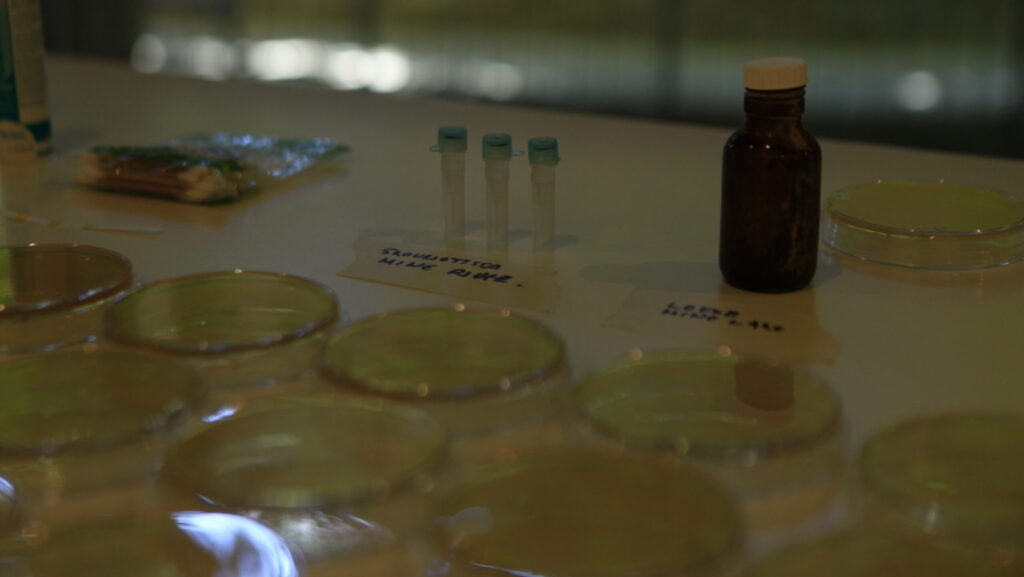
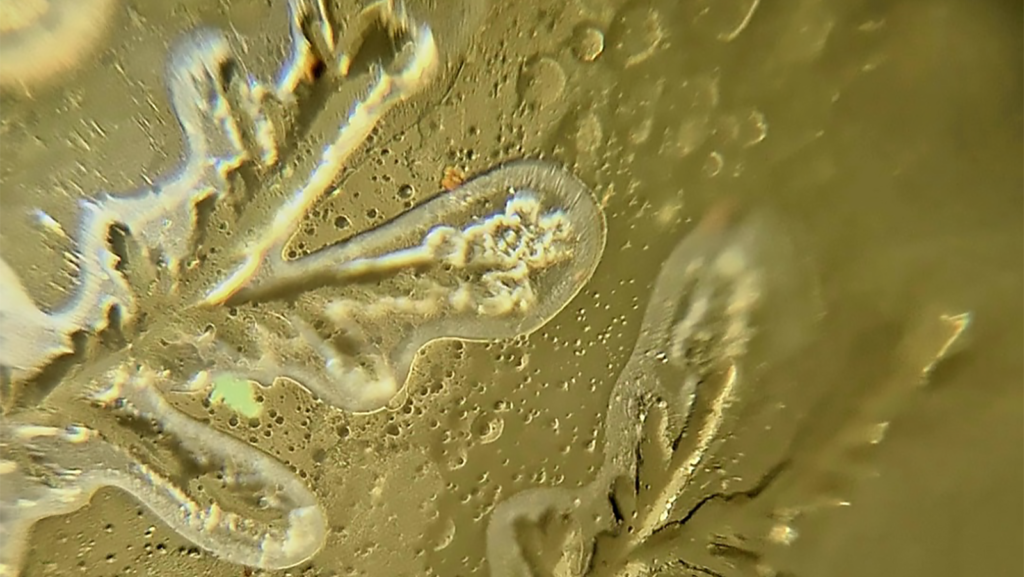

After we discussed the previous studies conducted on the chemical analysis of water bodies from Lefke and Skourtiotissa we used the readily available test strips to analyse the contents of the sample ourselves. The test strips measured the pH, total Alkalinity, the amount of fungicides, and chlorine present in the water samples (Figures 2 & 3). We then proceeded with the cultivation of the bacteria in the water samples.
The participants used copper coins (British pennies and European cents) to test how the existing microorganisms in the water samples would react to the copper inside the coins. Will the copper in the coin allow or inhibit other microbial communities to take over the resources offered in the agar medium? Initially we were thinking about the antimicrobial resistance of copper as we knew that it is a powerful fungicide and antimicrobial element that is resistant to pathogens. However, the bacteria in the water sample are already adapted to thrive in their copper contaminated ecosystems, and through these tests we concluded that the bacteria have no resistance to the copper inside the coins.
There seems to be one dominant type of bacteria colonising the dishes that is luminescent. The bacteria colonised the circumference of the coins and the underside. Copper and other metals that were already present in the water samples were crystallised on the surface of the nutrient medium (Figure 4). The water sample oxidised some of the copper coins and created spots of verdigris on them (Figure 5). Metaphors of microbial colonisation and microbial resistance as contamination can be applied to social theories that critically critique political colonisation. How resistant are we to colonisation, exploitation, and pollution of our land, our minds, and our culture?
We exhibited the results of the DIY workshop in EKATE (Cyprus Chamber of Fine Arts), under the title Atomic Number 29 (Figures 6 & 7). We also projected a short video that Dariia created from their visit to Lefke and Skouriotissa mines in June 2024 above the illuminescent petri dishes.
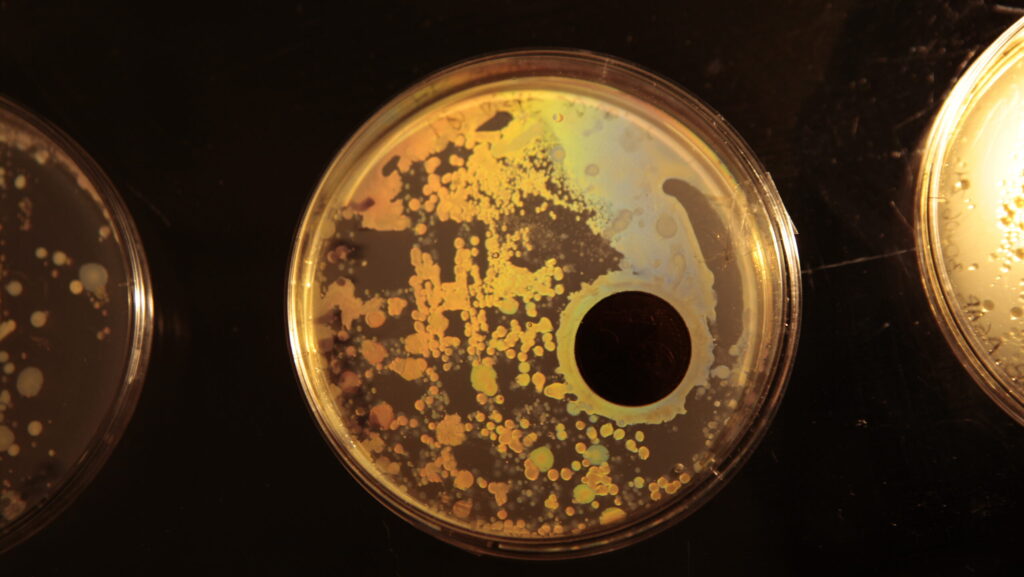
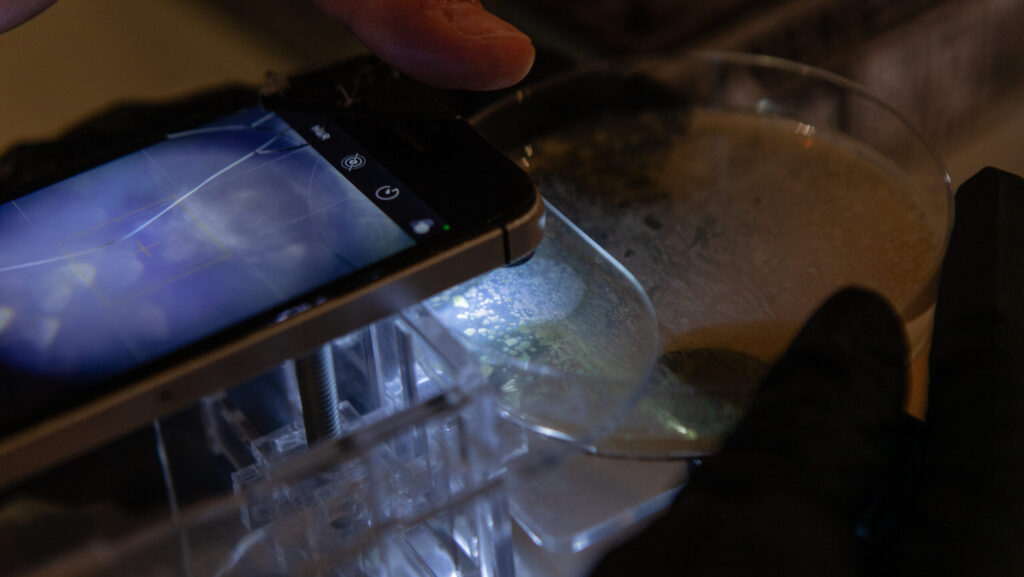


During November of 2024, Lucy Nychai, a Ukrainian curator working with D6:Culture in Transit (UK), created a digital group exhibition of all the projects from the (Re)Grounding programme. In the digital exhibition we included 3D experiences and 3D scans in combination with photography and video (Figures 9-11).
The exhibition titled (Re)Grounding: from beneath the ground to the future,⁵ is drawing parallels between the histories shared between the Ukrainian artists’ homeland and communities of the mining areas of Lefke and Skouriotissa in Cyprus and the North East of England. Taking the artists’ research and responses to create a journey, the exhibition begins deep in the earth, moving to extraction and invasion, then to gardening and finally looking to the future. The responses are multidimensional and range from poetry, performance, experimentation, film and photography, to incorporating collaboration, science and technology.⁶

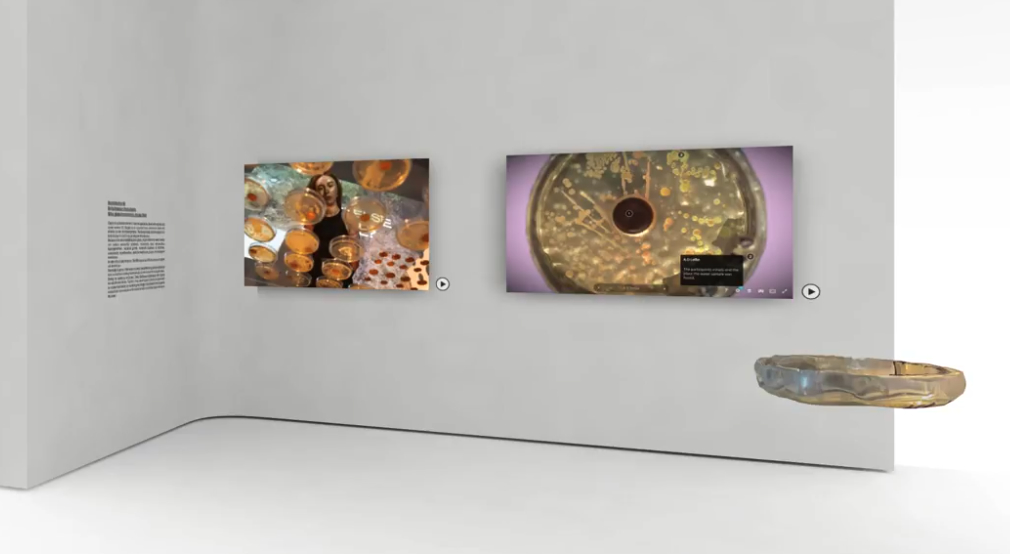
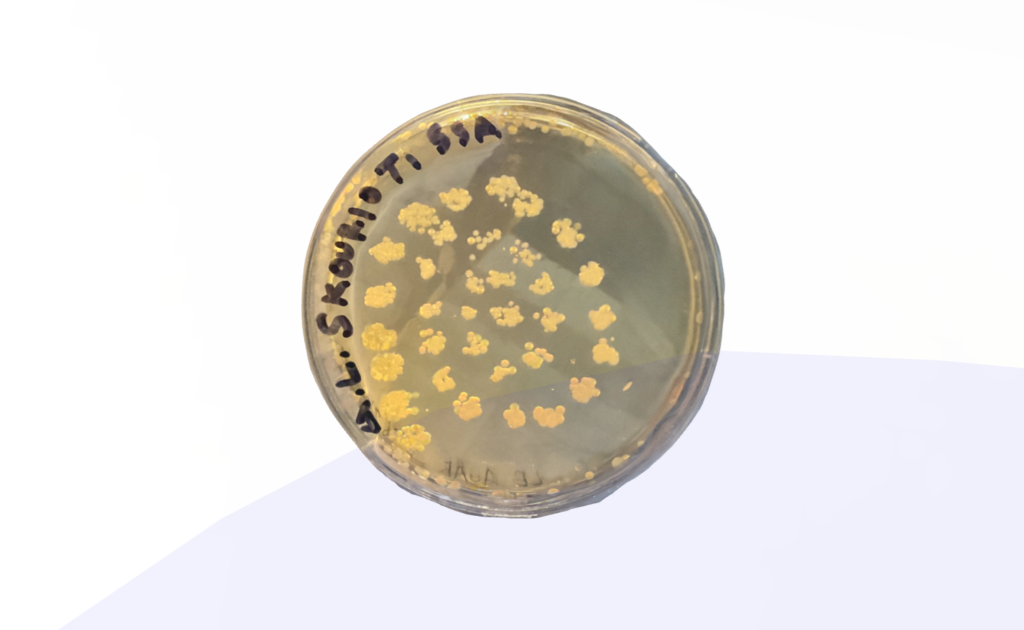
HB: Artists who base their work on environmental or technological concerns are mostly limited to accessible research by others such as field scientists and academics. In spite of the onsite visits you have done during the second half of the residency, do you feel that your citizen based research approach provided you with the depth and scope of relevant information?
MS: Yes, you are right, there is accessible research regarding the local mines but without taking into consideration the lived experiences of the community in terms of active monitoring or the impact of environmental pollution within these local communities. The research and the reports are quantitative and some of them are more than a decade old. Pictures of the polluted sites as well as the numbers that come out of the reports cannot fully reveal the extent of the pollution and the impact it still has on the local communities and their everyday lives. That is why we focused on more inclusive and citizen based research methodologies. To include more forms of research such as art making, lived experiences, empirical evidence, and to escape the limitations of accessible research by other field scientists and academics.
The long-term aim of this project is to create a citizen scientist community and take collective action to involve public engagement in scientific research activities, through citizens who actively contribute to science with their local knowledge, tools, and resources.⁷ In this way we can create accessible and enriching forms of experiences and knowledge outside of institutional structures.
What was missing from my research was the systematic visits to the sites to observe and monitor changes in the local ecosystems. I think that is what existing research by institutions is lacking, the element of community and the systematic monitoring of these areas.
We Forgot How to Forage: site explorations and documentation
HB: How does the multi-faceted nature of your subject matter inform your choice of documentation materials and techniques?
MS: I concluded my residency with on-site explorations in Mathiatis North and South [Strongylos] mines. I focused on conducting experiments using site specific materials, documenting empirical observations and gathering environmental evidence. I wanted to focus on ways I can collect empirical data about the current environmental state of the abandoned mines without further damaging the local ecosystem. Through my multidisciplinary research and practice approach, I combine a variety of techniques to convey the vital materiality of my subject. I think of my subject as an actant⁸ and aim to highlight emergence, agency and document its natural habitat and living conditions through 3D scanning and photogrammetry, visual microscopic mineral observation and DIY biology techniques.
During my visits to Mathiatis, I foraged site-specific materials like geological and mineral samples from the surface of the earth and the accessible ore bodies of the abandoned mines. To formulate further experiments and explore the materiality of these resources, I took them back to my DIY lab and observed them visually under my DIY microscope (Figure 12).
I digitally documented and collected the post mining landscapes, the local flora, and other evidence I could not take outside of the abandoned mines through 3D scanning and photogrammetry (Figures 13 & 14). This approach provided me with a wider understanding of the post mining ecosystem and the human environmental impacts which then instigated further experiments.
For example, my use of 3D scanning and photogrammetry to document my findings is a choice to avoid disrupting or further damaging the local biosphere but also to prevent heavy metal contamination in my biosphere like my car, my house and pets, and my DIY lab. 3D scanning and photogrammetry allows me to forage the source as evidence, collect it, and essentially transfer a digital version of my findings outside its habitat without physically extracting it, and removing it from the original site of its activity
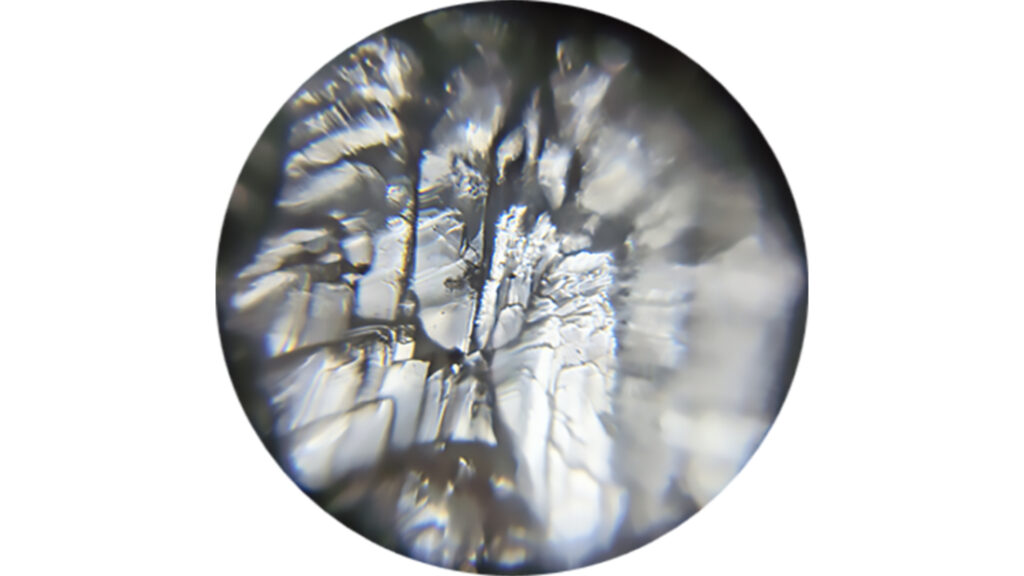
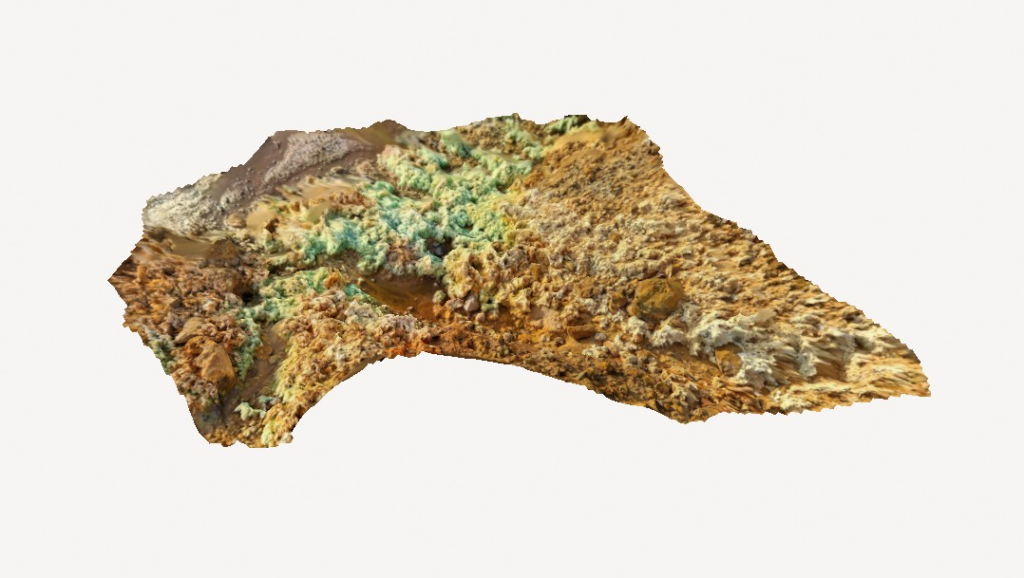

Apart from my personal explorations, through my collaborations with others and through my citizen science approach, I aim to co-develop open source protocols, tools, and resources collectively and inclusively. In this way, future community based resolutions for the active monitoring and remediation of local abandoned mines can be formulated. This approach allows for the cultivation of solidarity and action towards environmental justice through artistic production, the use of low tech open source tools and methodologies for documenting, analysing, testing, and monitoring abandoned local mines through non-hierarchical community exchange.
HB: When exploring such a vast concern as the Cyprus copper mines, your resultant accumulation of data must be at times, overwhelming. How do you contextualise all these findings and select relevant appropriate information to realise a final visual outcome?
MS: Sometimes I find it quite challenging to translate and curate all the different working mediums and research methodologies into a finished piece of art when preparing an exhibition because my work combines multiple approaches and techniques that originate from multiple disciplines. For the exhibition I decided to reproduce the on-site explorations and lab experiments through a series of installations. The installations included physical magnified projections of site-specific materials, digital projections and pepper’s ghost illusions of animated 3D scans in a variety of scales and magnifications, and DIY scientific explorations of the local bodies of waters and geological and mineral findings.
In the lab experiment section, the installation included the analysis of bodies of water of Lefke and Skouriotissa with the cultivated petri dishes and test strips from the DIY Biology workshop (Figure 15). I also displayed some of the open source tools I used for my visual microscopic explorations of geological and mineral findings like my DIY microscope and other magnifying apparatus that I designed and had it laser cut (Figure 16).
Towards the end of the residency, I researched more into readily available test strips that reveal more information through extensive testing including Lead, Mercury, Copper, Chromium, Iron, and many more (Figure 17). I also made my own pH sensitive dye using foraged Hibiscus flowers and pH sensitive pigment from some leftover red cabbage dye (Figure 18). Anyone can make pH test strips in their kitchen and if they store them in a dark, dry and safe place they can use them for a while.
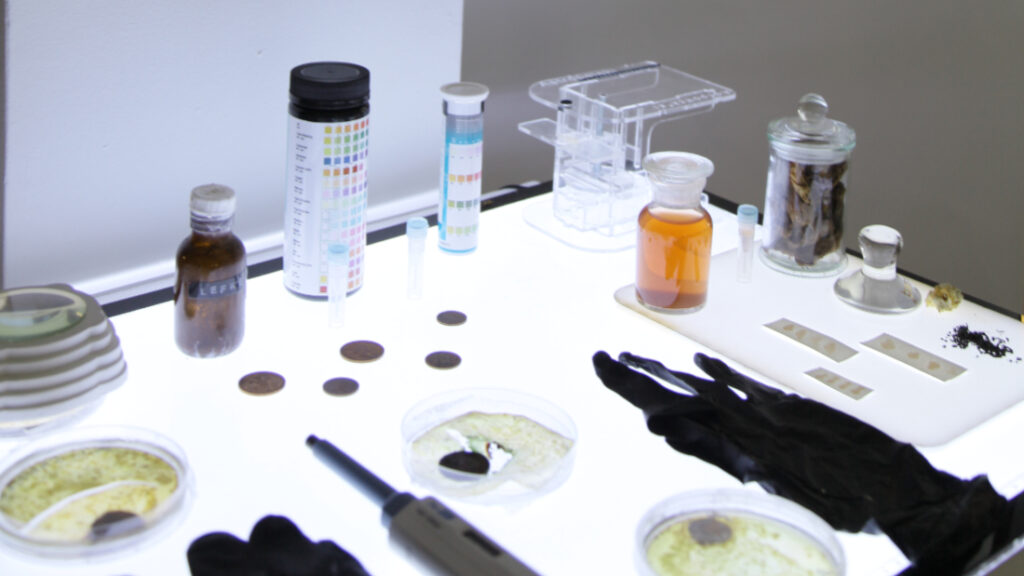
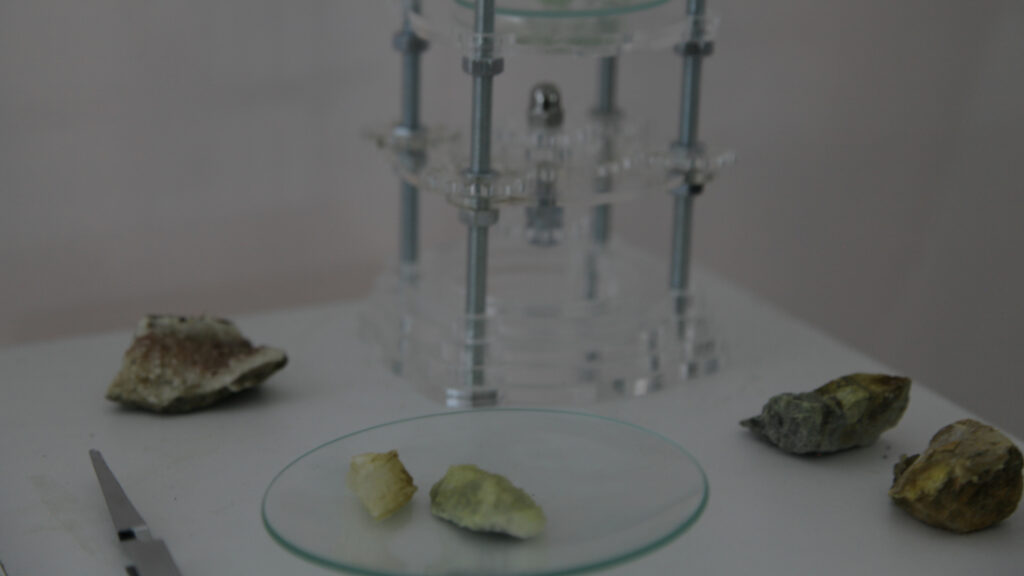
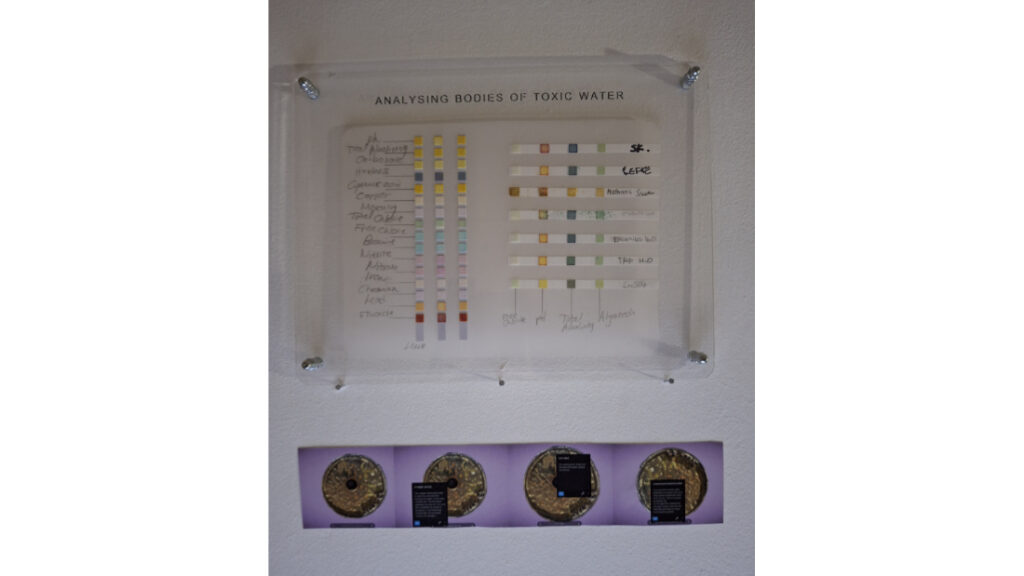
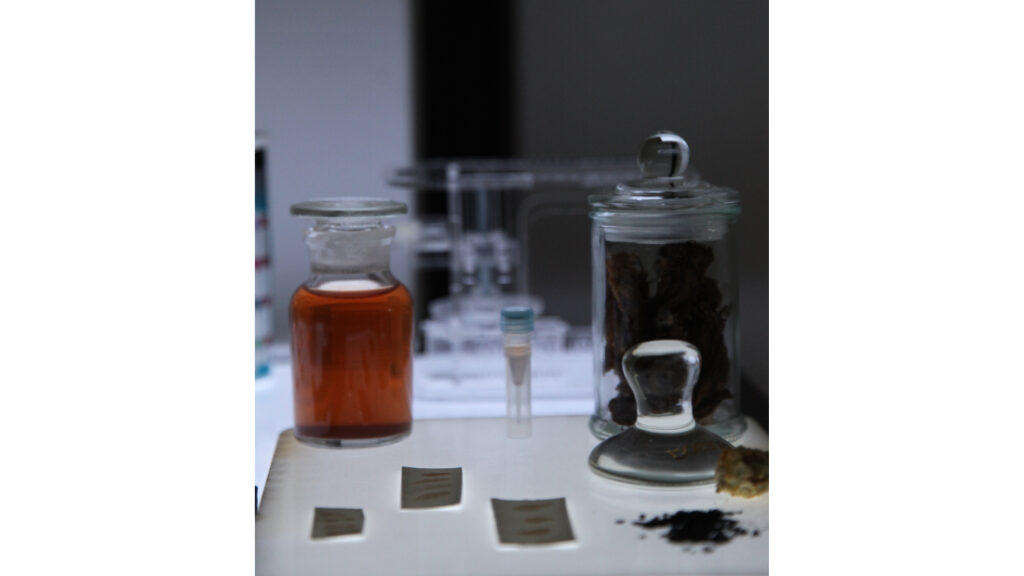
Some of cultivated petri dishes from the DIY Biology workshop have been preserved in resin to prevent them from complete dehydration and used as microscopic slides to create physical magnified projections (Figure 19). I used the same technique to project the magnified site-specific materials. These included mica crystals, crystallised sulphide lumps and various amalgamated rocks. I placed them on adjustable magnifying stands and were lit from below to create magnified projections of the site-specific materials on the ceiling (Figure 20). The stands were made from plexi glass and steel threaded rods that were specially designed, and laser cut to create these magnified projections (Figure 21).
Apart from the physical projections of the resin preserved cultivated petri dishes and mineral and geological site-specific materials, I also created another two installations with digital projections of animated 3D scans creating pepper’s ghost illusions. The illusions were enclosed within glass domes and placed on top of different sized monitors. Inside the glass domes I placed a piece of transparent membrane in the shape of the cross section of the glass dome in 45 degrees angle. In one of the installations, I used a tablet, and a specially designed laser cut box to contain the illusion and to block any light interfering with it (Figure 22 & 23). For the second installation, I used a pc monitor for my light source and a much bigger dome (Figures 24 & 25).
The larger central projection was created by fixing horizontally the projector onto a pedestal and projecting animations of the 3D scans of post mining landscapes and site-specific findings such as massive chunks of crystallised minerals and amalgamated stones. On the floor I placed a transparent sheet of plastic to reflect the animated 3D scans on the wall while magnifying the projections (Figures 26 & 27).
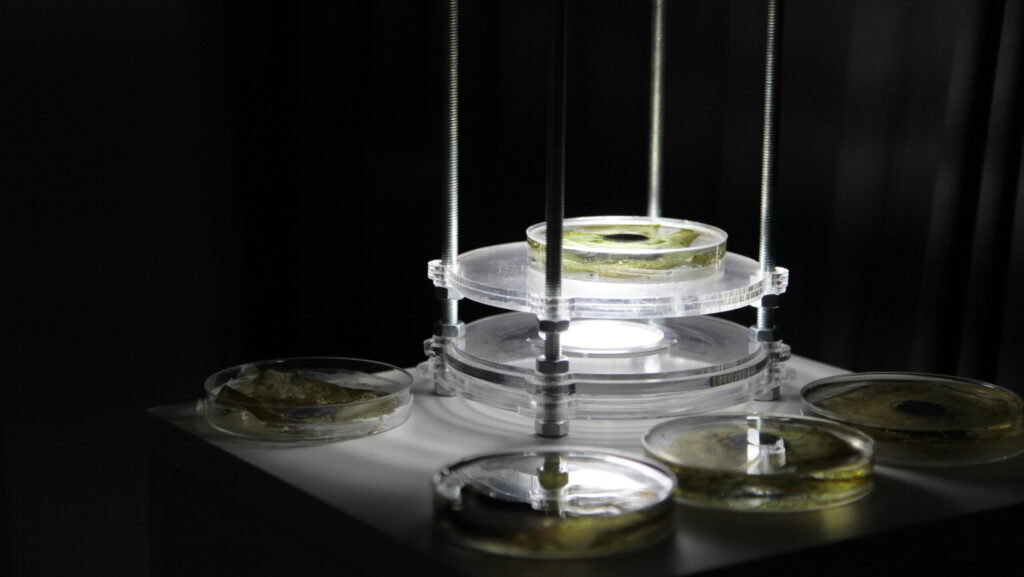

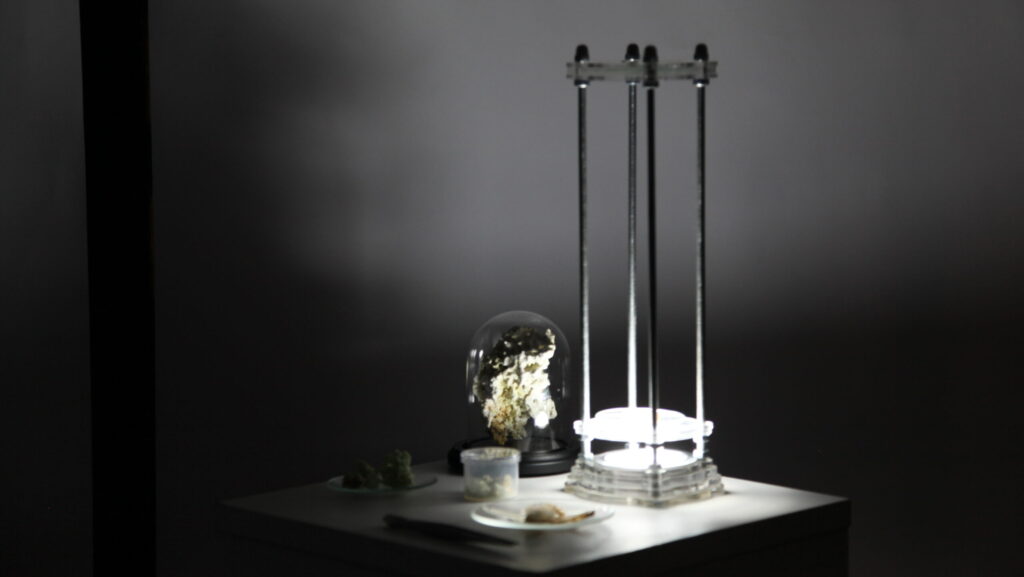
Apart from the physical projections of the resin preserved cultivated petri dishes and mineral and geological site-specific materials, I also created another two installations with digital projections of animated 3D scans creating pepper’s ghost illusions. The illusions were enclosed within glass domes and placed on top of different sized monitors. Inside the glass domes I placed a piece of transparent membrane in the shape of the cross section of the glass dome at a 45 degree angle. In one of the installations, I used a tablet and a specially designed laser cut box to contain the illusion and to block any light interfering with it (Figure 22 & 23). For the second installation, I used a PC monitor for my light source and a much bigger dome (Figures 24 & 25).
The larger central projection was created by fixing the projector horizontally onto a pedestal and projecting animations of the 3D scans of post mining landscapes and site-specific findings such as massive chunks of crystallised minerals and amalgamated stones. On the floor I placed a transparent sheet of plastic to reflect the animated 3D scans on the wall while magnifying the projections (Figures 26 & 27).



From left to right: Figure 22; Figure 23; and Figure 24

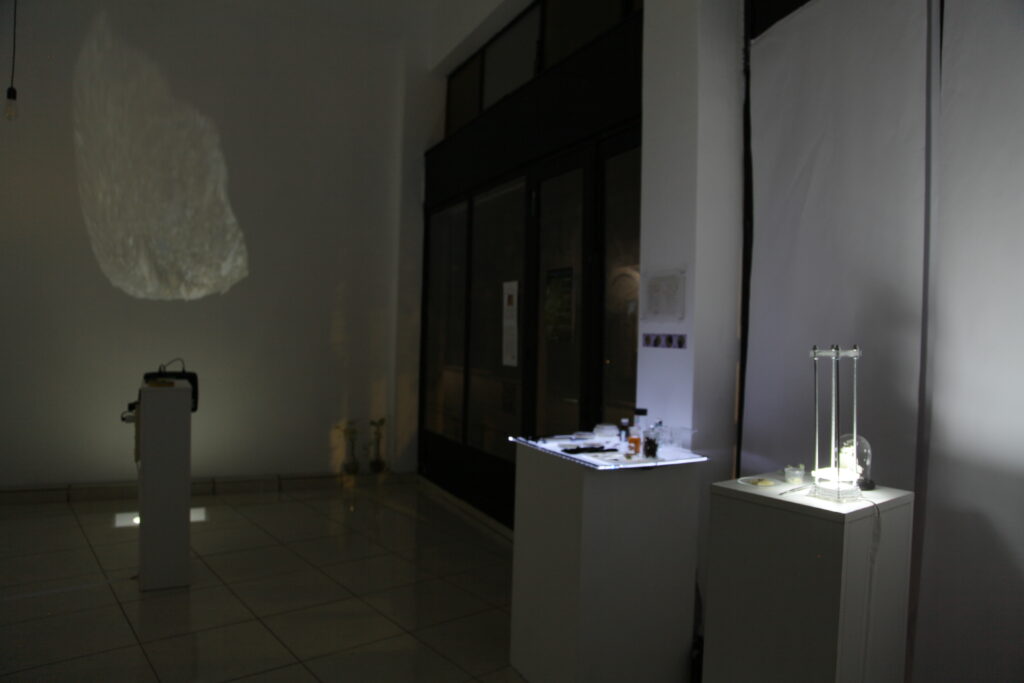
From left to right: Figure 27; Figure 26; Video
Post mining ecologies – Flora, soil and toxic bodies of water
MS: When I visited the abandoned mines in Mathiatis I observed and documented multiple types of flora and wondered if what I see today in these mines were always there, before the extractions by CMC began, and how they evolved and adapted within the changing landscape and the environmental pollution.
HB: Most of the mines that are operating now have been around since the Roman period because of the naturally occurring amount of copper in these areas. The plants found there must have acclimatised to their naturally copper-containing environments. Through your research have you identified plants that were indigenous to the land immediately surrounding mines in Cyprus?
MS: The adaptability of natural systems to thrive in toxic and inhospitable environments is a sign of discipline and resilience. Natural organisms and plants are essentially training themselves for survival by adapting to the local environmental conditions. The plants and trees found in abandoned mines today have evolved and adapted to survive their toxic environments.
It is indeed difficult to estimate how many plants have managed to adapt and survive until today because Cyprus copper mining dates back to around 4000 BC until the Roman period 200 AD. I found that the Mathiatis South (Strongylos) mine was richer in terms of biodiversity than the North Mine, although I noticed some plants that I did not see in Strongylos mine, like Echinops spinosissimus. In Strongylos I also had a very interesting encounter with a purple plant that almost camouflaged itself between the red, purple and ochre coloured stones on the ground (Figure 28). The plant was as big as my palm. I could not identify it yet unfortunately but I 3D-scanned it (Figure 29) and saved the coordinates of its location so I can go back anytime and check its progress.
In Strongylos mine, while walking on the trail leading to the mine, I found a huge area with Cistus creticus bushes and then along the trail I found another patch that combined at least 5 plant species and one type of lichen. Lichens are not plants; they are a hybrid species combining algae and fungi. I also 3D scanned this patch because it was too intriguing for me (Figure 30). This patch was like an ecosystem on its own within a larger ecosystem and a phenomenon of transpecies symbiosis. This is something I have not encountered before near any other mines I have visited, especially viewing with direct observation and without the use of tools for extending the senses like microscopy.

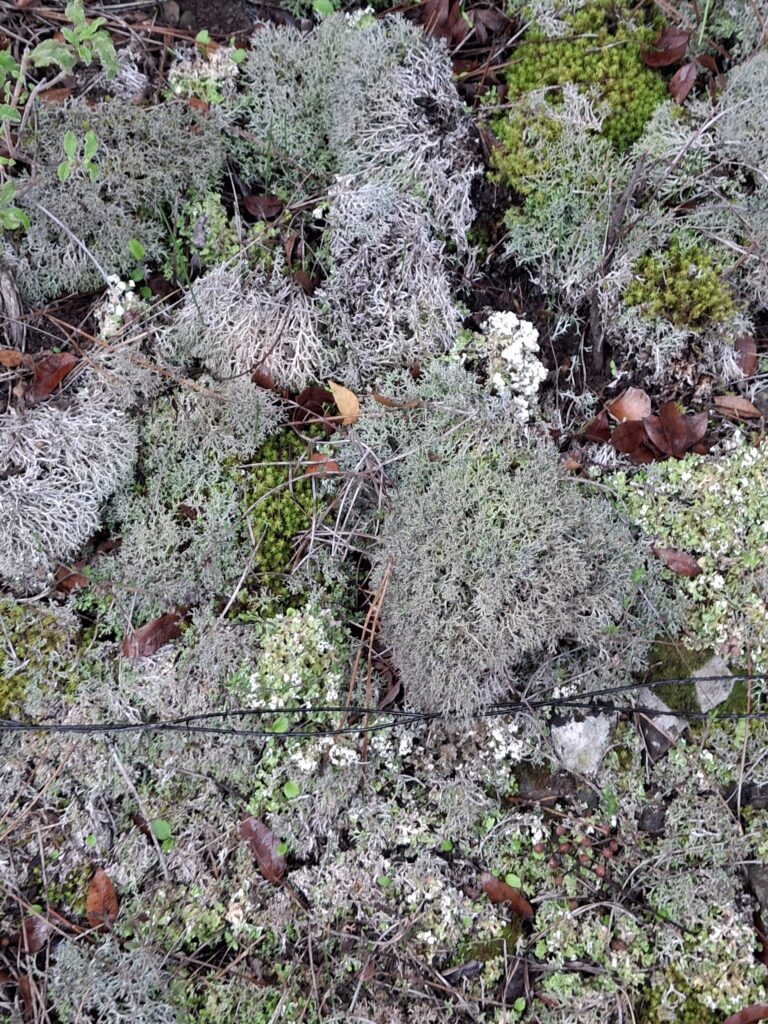
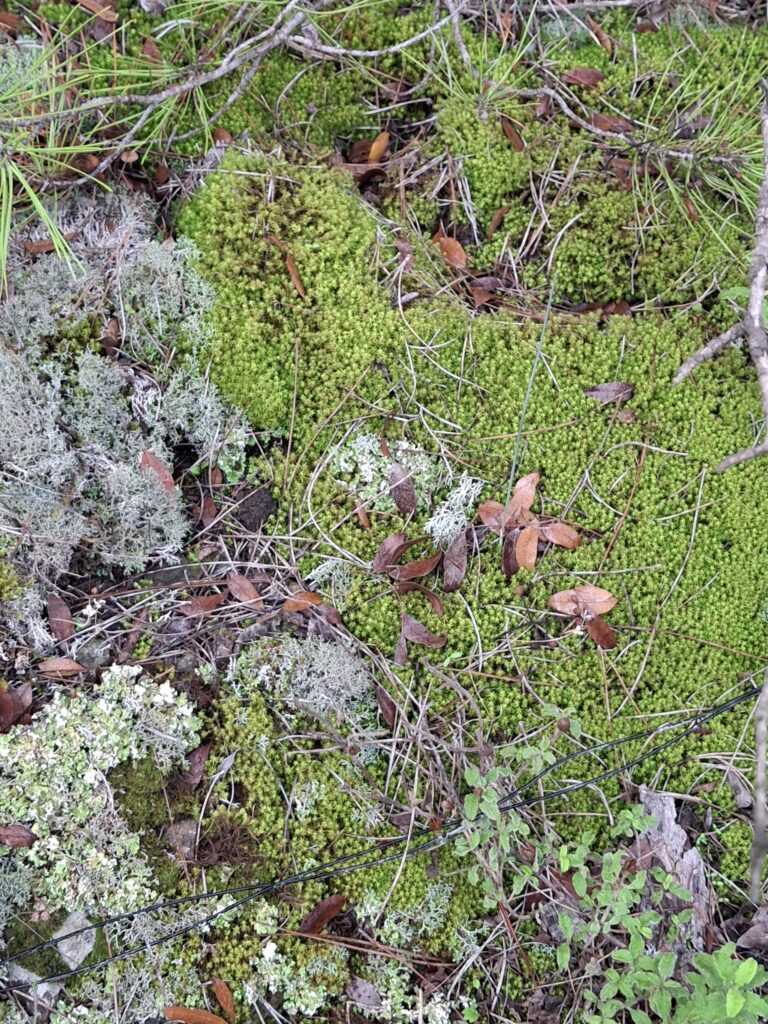


MS: The Sia mine, which is only 4 kilometers away from the South (Strongylos) mine is much richer in terms of biodiversity in certain areas, especially over the polluted lake. Apart from the indigenous plants, I also found some unusual lichen and fungi too. In Sia, I noticed many Cistus creticus bushes, Giant Fennel (Ferula communis) commonly known in Cyprus as αναθρήκα and Pinus brutia. On the leftover slag heaps I found some tiny looking lichen that can only be properly visible with a macro lens or a microscope. Between the Cistus creticus and Ferula communis I also found some fungi that I have not yet identified.
HB: Have other non-indigenous trees or plants developed some sort of evolutionary properties because of the high toxicity in water and soil? Can you speak about these aspects in context of your findings of local toxic resistant land plants for phytoremediation and monitoring of the abandoned ecosystems? How is this information important for the future and the rehabilitation of abandoned mines?
MS: I have not observed many non-indigenous trees or plants in the mines. In Mathiatis South (Strongylos) mine and in Sia mine I noticed some Agave Americana plants which made a huge impression on me. I remember through a previous conversation we had you mentioned that these plants were planted by someone who lives nearby and wanted to be reminded of their home in South Africa. That made a lot of sense because I felt that these plants were introduced to the post mining ecosystems much later as I did not find them anywhere else in the surrounding areas. They were situated by the side of the pit, across from the leftover ore bodies. They were the first plants I saw when getting closer to the mining area. I am sure that there are other candidate species apart from the indigenous ones that can also adapt to their toxic surroundings, depending on the type of flora.
After conducting more research on the flora I found in the mines, I realised that most of the plants I encountered are being studied for the rehabilitation of the abandoned mines through phyroremediation.⁹ There is a long list of indigenous flora that have adapted to the post mining conditions and evolved to hyperaccumulate heavy metals and survived the heavily polluted mining environment. These plants along with lichens and moss are used as bioindicators of environmental pollution and heavy metal contamination and through deeper studies we can gain a better understanding of the overall health of the environment and the potential impacts of heavy metals on ecosystems.¹⁰
One study on the rehabilitation of abandoned sulphide mines in Cyprus in Kokkinopezoula and North and South Mathiatis mines has found potential use of native plants such as Phragmites australis, Tamarix smyrnensis, Pinus brutia, Cistus creticus and Schoenus nigricans could be applied for the phytoremediation of abandoned sulphide mines.¹¹ Indigenous flora grows naturally on different parts of the waste dumps, exhibiting tolerance to this toxic environment.
In 2011, the research on the Lefke Copper mine conducted by Gulay Cetinkaya and Nur Sozen¹² identified both native and introduced plant species that survived in the heavily polluted mining site. The number of candidate plant species revealed that several plant species thrive well in the contaminated site including 5 trees, 4 shrubs, and 23 herbaceous plant species. These were proposed for starting revegetation with the purpose of phytostabilisation on the CMC mining site.
I consider this information very important for exploring the possible conditions for the future ecological rehabilitation of abandoned mines using phytoremediation as an important means to reduce and control heavy metal pollution. However, what I consider more relevant for us today is the fact that many indigenous and introduced plants have developed a resistance to copper toxins in soil or tailings and in some cases, they thrive despite the environmental degradation. This has been a motivator for me to pursue further explorations of plants that successfully grow and stabilise potentially hazardous elements in copper mining areas.
Exploring the biodiversity of such places is important information because plants, fungi, lichen and even fauna are bioindicators themselves. They are nature’s biographers and when certain species are present, they can reveal fruitful information that is very often autobiographical. I also have a very special interest in the study of lichen as they are valuable for monitoring the heavy metal pollution of mines because they are bioindicators¹¹ of air quality and pollution and have long lifespans. Their existence is also a sign of resilience because they can survive in some of the most barren and severe regions of the world. They can tolerate extreme weather conditions through dormancy and have the ability to recover quickly when conditions are favourable.¹³
MS: How are the affected and polluted bodies of water and soil still affecting our everyday lives, the quality of what we eat, drink, the way we explore our surroundings, and the way we cultivate our food or grow our plants? How aware are we regarding heavy metal pollution upon our surroundings, our health and food?
HB: I visited Lefke in 2019 and discussed with Ahmet Hizli¹⁴ from the Environmental Society of Lefke, the environmental impacts from the mining at the Phoenix mine located in Foucassa Hill, Skouriotissa. Due to the topology, the accumulated toxic water mixes into the underground streams when there is substantial rainfall. The northern slope of the mountain allows this toxic mixture to accumulate near the “red cliff” in Apliki and then reaches the underground reservoir which supplies water to the towns of Kalo Chorio, Peristeronari and Lefke. Due to heavy rains in early 2019, Lefke was flooded with green foamy water mixed with mining waste which when tested revealed it contained heavy metals such as arsenic, cadmium, lead and iron. These tests, initiated by the Environment Society of Lefke, proved to be way over the limits recommended by the European Union. Unfortunately, the fruits and vegetables grown in this region were and continue to be contaminated. Due to lack of awareness and financial reasons, people continue to consume them which explains why Lefke has the highest cancer per capita in Cyprus.
MS: It is evident that post mining ecologies are still significantly affecting our quality of life, our ecosystems, and our commons, in visible and invisible ways. The earth remembers and we are all still experiencing the consequences from the abandonment of the mines through the lack of responsibility, legislation and rehabilitation measures, to restore decades’ worth of exploitation, environmental degradation and pollution.
HB: As Jussi Parikka mentioned in Media Archeology,¹⁵ “Human’s leave their mark and the earth carries it forward like an archive”. In order to reprocess the present and look to the future, we need to explore the events of the past within the current global discussion about the demise of our environment, especially through monetisation and militarisation. We live in a techno-capitalist world system which encourages usurpation and consumption of human and non-human resources.
Resolutions – restoration and environmental justice
MS: There is a myriad of accessible research papers around the restoration of abandoned mines that focus on bioremediation and more particularly, phytoremediation, as a resolution for post mining ecologies. The research is carried out in labs and behind the closed doors of scientific institutions. However, none of them suggest any drastic, practical, efficient, or community-based resolutions for the restoration of the abandoned mines.
HB: Yes, I agree. I believe that the obstacle to effective solutions being implemented to rectify this historical and continuing disaster is manifold but for the purpose of our discussion, I will mention two. The first is political. Governments are fluctuating and short-lived institutions made up of mostly self-serving individuals. No politician is willing to support an issue that is not only proportionally vast geographically but secondly, the hazardous toxins require a process of filling and sealing that makes it extremely expensive and risky due to the many years of neglect and unregulated pollution controls. Finally, the present obsession with rare earth minerals under the hypocritical cover of environmental protection means that these existing copper mines are now becoming exploited again with further extraction. So to appear environmentally proactive, it is preferable to support less expensive research, even though many papers are repetitive and referential to existing studies offering no feasible and innovative solutions. So again, it is a matter of profit over nature.
MS: We understand from first-degree testimonies that the damage is irreversible and no amount of national money or EU funding can solve the issue. The mines were abandoned by CMC decades ago without the prospect of restoration. At the same time most Cypriots are still unaware, denying or ignoring the extent of the environmental pollution coming from the mines thinking that there is no way they could be directly affected by it. There is a lack of citizen awareness, lack of community knowledge produced or exchanged, and this type of research and knowledge stays within the scientific community. How can we focus on the future rehabilitation of the mines and our well-being as a community? How can we as citizens, artists, bioactivists raise awareness and cultivate networks of solidarity toward environmental justice
HB: This is an insurmountable problem and unfortunately, I do not have a positive answer. There are non governmental groups of dedicated and very well-informed environmental activists such as the Historical and Environmental Group of Mathiatis and the Environmental Society of Lefke, as well as other smaller groups mobilising to generate community awareness and participation. Unfortunately our Cypriot community in general is not interested in activism, either environmental nor political and unfortunately both these areas are required in tandem in order to move toward some form of justice. Resolving the “Cyprus problem” will always be quoted as a reason for non-committal to environmental issues. Natural environments, ecosystems and people’s health will now continue to be destroyed by mining corporations under the banner of clean energy. According to the Cyprus Mines Service¹⁶ the prospecting activity which exists today in many of the 30 mines located on the island is for gold, copper as well as other metals. This heightened activity has been, and still is, with full support of the government no matter which political party is in power.
So to partly answer your question, the most that we should do is aim to increase the remediation and recycling of existing copper waste and leave the rest in the ground where it belongs.
Footnotes
- Helene Black is an artist, educator and cofounder of the interdisciplinary NGO, NeMe.
- (Re)Grounding, D6:EU. (Re)Grounding 2024 is a partnership between IZOLYATSIA (Ukraine), D6:EU (Cyprus) and D6: Culture in Transit (UK). The programme is supported by: the UK/UA Creative Partnerships programme created by the British Council in partnership with the Ukrainian Institute; European Cultural Foundation; Arts Council England; the Deputy Ministry of Culture of the Republic of Cyprus and the Paul Hamlyn Foundation.
- Dariia Dantseva is a biohacker, interdisciplinary artist, founder of Ukraine’s first DIY biohacker space Yanelab, and a member of the international group of biohackers Central Dogma Collective.
- Eco Anarchist Collective
- (Re)Grounding: from beneath the ground to the future, digital exhibition
- (Re)Grounding: from beneath the ground to the future, digital exhibition
- Ramos-Carvalho, Priscila & Gouveia, Fabio. (2022). Contributions of decolonial thinking to citizen science.
- Jane Bennett, Vibrant matter: a political ecology of things, Duke University Press, 2020
- Phytoremediation is defined as a bioremediation technique that uses plants and soil microbes to reduce hazardous contaminants in the environment, particularly heavy metals, by absorbing and fixing them in plant tissues.
- Marinos Stylianou, Ifigenia Gavriel, Ioannis N. Vogiatzakis, Antonis Zorpas, Agapios Agapiou, Native plants for the remediation of abandoned sulphide mines in Cyprus: A preliminary assessment, Journal of Environmental Management, Volume 274, 2020, 110531, ISSN 0301-4797, https://doi.org/10.1016/j.jenvman.2020.110531.
- Arlinda Cakaj, Kinga Drzewiecka, Anetta Hanć, Marta Lisiak-Zielińska, Liliana Ciszewska, Maria Drapikowska, Plants as effective bioindicators for heavy metal pollution monitoring, Environmental Research, Volume 256, 2024, 119222, ISSN 0013-9351, https://doi.org/10.1016/j.envres.2024.119222.
- Cetinkaya, Gulay, and Nur Sozen. 2011. “Plant Species Potentially Useful in the Phytostabilization Process for the Abandoned CMC Mining Site in Northern Cyprus.” International Journal of Phytoremediation 13 (7): 681–91. doi:10.1080/15226514.2010.500155. accessed 18/10/2024
- Lichen, Nasa earth observatory.
- Helene Black, video – What we have forgotten to remember, 2019, interviews Ahmet Hizli
- PARIKKA, JUSSI, et al. A Geology of Media. University of Minnesota Press, 2015.
- Number of copper and gold mines, 21 mines in the Nicosia district, 4 in Larnaca district, 5 in the Paphos district, https://www.moa.gov.cy/moa/Mines/MinesSrv.nsf/all/.






